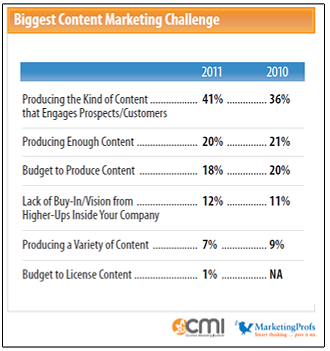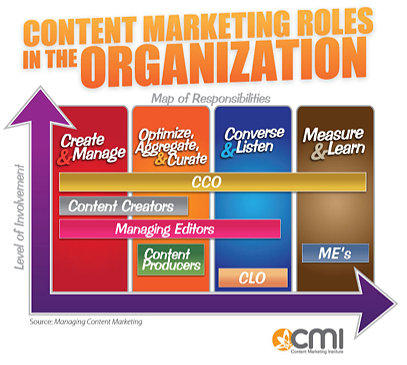 [Note from Lee: The next in our series of Wednesday guest posts comes from no less than the Godfather of Content Marketing, Joe Pulizzi. I’ve known Joe since he published his first book, Get Content Get Customers, and have been amazed at his relentless efforts to lead the charge towards better marketing.
[Note from Lee: The next in our series of Wednesday guest posts comes from no less than the Godfather of Content Marketing, Joe Pulizzi. I’ve known Joe since he published his first book, Get Content Get Customers, and have been amazed at his relentless efforts to lead the charge towards better marketing.
 What I like best about Joe is that he’s a “Walk the Talk” content marketer with Junta42, Chief Content Officer magazine and the largest annual content marketing event, Content Marketing World. Joe is also co-author of Get Content Get Customers and Managing Content Marketing plus he writes a content marketing blog. For this post Joe focuses on what businesses need to know about smarter planning for content marketing into the coming year.
What I like best about Joe is that he’s a “Walk the Talk” content marketer with Junta42, Chief Content Officer magazine and the largest annual content marketing event, Content Marketing World. Joe is also co-author of Get Content Get Customers and Managing Content Marketing plus he writes a content marketing blog. For this post Joe focuses on what businesses need to know about smarter planning for content marketing into the coming year.
According to the latest research from the Content Marketing Institute and MarketingProfs, 90% of non-media companies create original content, in some shape or form, to attract and retain customers. Yes, we are indeed all publishers today. 
The biggest challenge? Creating compelling content.
Let’s face it … content marketing is a new muscle for most organizations.
Most brands have been doing things the same way for so long that thinking like a publisher is, well, quite taxing. Worse yet, we aren’t set up for publishing; we’re set up for traditional marketing practices set up in the usual organizational silos. That means we might not have an awareness of the types of roles needed to succeed with managing the content marketing process. And in order to get it done, you need the following four things:
- People to do it
- Roles and responsibilities for those people to fill
- A schedule by which the tasks are fulfilled (editorial calendar)
- Rules and guidelines
The most difficult of these may be finding the roles within our company to drive the process. If that’s the case for you, here’s the answer.
Assembling the Team, their Roles and Responsibilities
Given the size of your organization, you may have one person – or many – responsible for your content marketing initiative; however, in general, no matter how many people actually take responsibility for the function, the following roles are needed. NOTE: These are roles within the organization, not necessarily position titles (although they could be).
The Manager — or Chief Content Officer (CCO)
At least one person in your organization should own the content initiative. More recently, organizations have been calling this a chief content officer (CCO). Kodak calls this role the vice president of content strategy; social media technology company Radian6 calls it the director of content marketing (here’s a full Chief Content Officer job description). This is the “chief storyteller” role for your content effort and is responsible for executing the goals that you set out to accomplish. When content marketing fails, it’s usually not because of a lack of high-quality content, but because of a drop in execution. This is why this manager may be your most important asset, even though this person may not be creating ANY of the content. The CCO must ensure excellence in every content marketing tactic including:
- Content/editorial
- Design/art/photography
- Web resources for content
- Integration of marketing and the content, including social media
- Project budgeting
- Contract negotiation with freelancers
- Audience development
- Research and measurement
In organizations where there is no budget for a dedicated CCO, this role may be filled by the director or vice president of marketing. Many brands, such as UPS, have a manager inside the company who oversees internal content production as well as the production of content by an outside agency. Although brands can outsource a wide variety of content production through outsourced vendors, it’s important to keep the CCO inside the organization.
The Managing Editor(s)
The editors have a critical role in the content marketing process, and are probably the most sought after by brands today. As more brands develop content, employees are being asked to blog and write on behalf of their companies. Unfortunately, the writing style of employees who have never created content before often leaves much to be desired. That’s where the managing editor comes in. This role, sometimes outsourced, and sometimes part of the CCO’s responsibility, manages the editorial functions of the content marketing effort. These are your day-to-day content execution people. They help internal employees develop and write content, and they help external people match their writing to meet the organizational goals. The managing editor works with the employees on:
- Content production
- Content scheduling
- Keyword selection
- Search engine optimization of posts
- Style corrections
- Tagging and images
Sometimes the managing editors are there to teach, so the employees can do more on their own. They also may act as coaches, encouraging the managers, executive team, or even external writers to produce content against the schedule. OpenView Venture Partners, a VC firm based in Boston, has a managing editor who oversees all the content on the OpenView blog, but only creates a small portion of it. Nearly every employee is responsible for developing original blog posts, so the managing editor edits content from the entire enterprise.
Content Creators
Content creators produce the content that will ultimately help to tell the story. This role typically overlaps with the managing editors who are also producing content, but also may simply be subject matter experts within the organization. For example, typical content producers include anyone in the C-suite, the head of R&D, the product manager, the customer service director, or a hired consultant. In many cases this role is outsourced when there is a lack, or gap, in resources to produce the content. It’s important to note that this person does not need to be a writer (although it’s really helpful if they are). In general, they are there to be the “face” or “voice” of the authentic organization. They may be interviewed for content, or they may produce a long, rambling email that is transformed into a cogent blog post.
Content Producers
Content producers format or create the ultimate package that the content is presented in (i.e., they make the content pretty). Chances are this role already exists in your organization to some degree; it is either handled in-house or by an agency. It might be a Web agency if the end product is a blog or a Web site.
Chief “Listening” Officer (CLO)
The role of the CLO is to function as “air-traffic control” for social media and your other content channels. They are there to listen to the groups, maintain the conversation, and to route (and/or notify) the appropriate team members who can engage in conversation (customer service, sales, marketing, etc.). For the content marketing process, this function serves as the centerpiece of our “listening posts.” You establish listening posts so you can continue to get a “feed” of information so that you can always be ready to react and adapt as your subscribers react and change.
 Making the Content Marketing Process Work
Making the Content Marketing Process Work
Where do these roles fit in the content marketing process? Let’s look at this map:
As you can see, the CCO stays engaged throughout the entire process. His or her role is to focus on the entire process and make sure that it runs smoothly and meets the goals set forth in the strategy.
The content creators are purely focused on the creation and management stage of the content marketing process. They may be fed with information gleaned during the measurement and insight phase, but their time is squarely dedicated to creating.
The managing editors play an equally important role during the creation and management phase and also shepherd the content through the optimization and aggregation phase. This role may also play into the conversing and listening phase, especially as they work to make sure content is meeting editorial, SEO, or other guidelines; however, their role lessens as the content moves out into the “live” environment and is consumed.
The content producers are almost exclusively focused on the optimization and aggregation phase, as they design, format, and produce the content in whatever end form it will take.
The CLO focuses on the Converse & Listen phase. In some cases they will actually conduct the conversation that ensues – but more likely are the “ears” of the organization.
Their job is to quickly and efficiently route the conversation to the appropriate part of the organization. Each role shifts as the process goes forward, and the percentage of time or attention that each person spends is allocated accordingly. If you look at this mapping as a part of your initiative, you can begin to envision how the workflow for the team might have to be allocated, especially given the volumes of content, the velocity, and how much external communication will be necessary.
If managing the content marketing process is something your organization is challenged with, Robert Rose and I just wrote the aptly named Managing Content Marketing: The Real-World Guide to Creating Passionate Subscribers to Your Brand.


